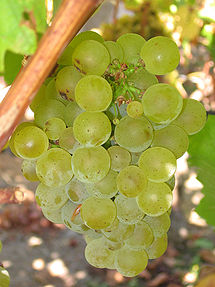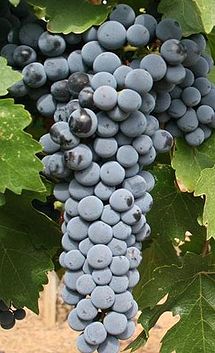 
ANPC:
http://www.anpc.gov.ro
|

|
Cramposie
Based on historical facts, but also on the fact that the winery activity continued without obstacles to our days, I can confirm that Cramposie wine variety
is very old, beind harvested since the times of the geto-daci.
Sterile variety (the flowers of the vine can not reproduce by themselfes), it was planted together with Gordan, which is another romanian wine variety with good
reproductive qualities. To these two varieties, the locals add also Braghina and a little bit of Tamaioasa Romaneasca.
In conclusion, we can say that the old variety from Dragasani terroir, until the phyloxera (1884) was formed from
Cramposie 30%, Gordan 30%, Braghina 30% and Tamaioasa Romaneasca 10%. Using the same coupage was obtained also the
famous Tulburel de Dragasani or Tulbure de Dragasani, a new wine, obtained at few weeks from harvest.
Interesting to know is the fact, that throught the time, Cramposia had many names, being known by winemakers from Oltenia
as Carlonga and Baldoaie. Later, after spreading in the Dealu Mare area, the local winemakers named it Ciolan.
Cramposia is a very powerful wine variety, producing huge harvests sometimes, with a toll on the quantity and
quality of the grapes.
In 1972, a group of researchers from SCVV Dragasani obtained a new variety called Cramposie Selectionata. Unlike Cramposie,
with flowers functionally females with strong repercusions in terms of reproductive function, the Cramposie Selectionata
variety has hermafrodite flowers and it is not expierecing such problems.
Unlike the old Cramposie, with mixed characteristics and also very high quality grapes for consumption, Cramposia Selectionata
is only destinated for winemaking.
The white wines produced are, in general, dry, balanced and fruity. Through freshness and lightness, it leaves a delightfull
freshness in the mouth when they are tasted.
Dr. Ing. Ec. Ion Pusca - oenolog
|
|
Feteasca regala
Feteasca Regala is a variety from Transilvania and harvested in the majority of the vineyards from Romania.
The grape was identified around 1920 in Tarnave vineyard, more exactly in the Danes village.
This is why the locals named it: Danasana, Danaseana, Danesana or Dunasana.
In the specialized literature it was named Galbena de Ardeal.
The wines obtained from this variety have a quality which varies from good to outstanding.
Wikipedia
|

|
|

|
Sauvignon blanc
The Sauvignon Blanc grape traces its origins to western France in the Loire Valley and Bordeaux Regions. Ongoing research suggests it may have descended from savagnin. It has also been associated with the carmenere family. In the 19th century, plantings in Bordeaux were often interspersed with Sauvignon vert as well as the Sauvignon Blanc pink mutation Sauvignon Gris. Despite the similarity in names, Sauvignon Blanc has no known relation to the Sauvignon Rosé mutation found in the Loire Valley of France.
The Sauvignon Blanc vine often buds late but ripens early, which allows it to perform well in sunny climates when not exposed to overwhelming heat. In areas where the vine is subjected to high heat, the grape will quickly become over-ripe and produce wines with dull flavors and flat acidity. Global warming has had an effect on the Sauvignon Blanc grape, with the rising global temperatures causing farmers to harvest the grapes earlier than they have in the past. At its most unripe stage, the grape is high in malic acid. As it progresses further towards ripeness the grape develops red & green pepper flavors and eventually achieves a balance of sugars. The flavors characteristic of Sauvignon Blanc come from the chemicals methoxypyrazines.
Sauvignon Blanc can be greatly influenced by decisions in the winemaking process. One decision is the amount of contact that the must has with the skins of the grape. Another important decision is the temperature of fermentation. Oak aging can have a pronounced effect on the wine, with the oak rounding out the flavors and softening the naturally high acidity of the grape.
Wikipedia.
|
|
Tamaioasa romaneasca
This variety traces its routes to the antique Greece. In Romania it was harvested before the phyloxera and this is the reason for considering it local.
The grapes are middle sizes, conic or cilindric-conics.
The middle of the grape is spheral, with yellow-green skin, with rust staines; consistent pulp with sweet taste.
It has a medium period of vegetation (165-175 days) and high thermal demands, it has medium growth power and good fertility of 55-65%.
The maturity is obtained at 2-3 weeks after Chasselas dore.
It is a friendly variety, frost sensible (-18°C -20°C), draught or excess humidity sensible, highly attacked by diseases, grapes moths and wasps.
It preffers areas with long, sunny and dried autumns, which allow easy accumulation of sugars and flavours in the must.
Gazeta de agricultura
|

|
|

|
Negru de Dragasani
Negru de Dragasani variety created at SCVV Dragasani, Valcea county are in measure to enter in competition with any other
variety of red wines, concerning the composition parameters, but with productions that have superior levels regarding
Cabernet Sauvignon, Pinot noir and even Merlot.
Cultivated in the southern half of the Dragasani vineyard, in the area wandered by the stream Dalga, Mamu and Beica and of by
the river Oltet, the Negru de Dragasani variety show a productive and qualitative potential of high oenological level.
This potential is expressed through productions, which can exceed constantly 10 t/ha, through relative contents in glucides, acidity,
anthocyans ant total polyphenols. These characteristics of grapes are reflected extremely positive in the characteristics of composition
and the organoleptic properties of wines.
Negru de Dragasani is happily completing the indigene assortment for red wines, much more solicited on the meridians of the world.
In the same time is successfully accomplished the condition enforced by UE concerning the wines promotion from national, indigene varieties.
C. Nicolaescu, M. Gheorghita
|
|
Cabernet Sauvignon
Cabernet Sauvignon is one of the world's most widely recognized red wine grape varieties. Despite its prominence in the industry, the grape is a relatively new variety, the product of a chance crossing between Cabernet franc and Sauvignon blanc during the 17th century in southwestern France.
Winemaking
During the maceration period, color, flavor and tannins are extracted from the skins. The addition of stems and seeds will increase the tannic content of the wine.
The tannic nature of Cabernet Sauvignon is an important winemaking consideration. As the must is exposed to prolonged periods of maceration, more tannins are extracted from the skin and will be present in the resulting wine. If winemakers choose not to shorten the period of maceration, in favor of maximizing color and flavor concentrations, there are some methods that they can use to soften tannin levels. A common method is oak aging, which exposes the wine to gradual levels of oxidation that can mellow the harsh grape tannins as well as introduce softer "wood tannins". The choice of fining agents can also reduce tannins with gelatin and egg whites being positively-charged proteins that are naturally attracted to the negatively-charged tannin molecules. These fining agents will bond with some of the tannins and be removed from the wine during filtration. One additional method is micro-oxygenation which mimics some of the gradual aeration that occurs with barrel aging, with the limited exposure to oxygen aiding in the polymerization of the tannins into larger molecules, which are perceived on the palate as being softer.
Affinity for oak
One of the most noted traits of Cabernet Sauvignon is its affinity for oak, either during fermentation or in barrel aging. In addition to having a softening effect on the grape's naturally high tannins, the unique wood flavors of vanilla and spice complement the natural grape flavors of black currant and tobacco. In winemaking, the decision for the degree of oak influence (as well as which type of oak) will have a strong impact on the resulting wine. Winemakers often use a variety of oak barrels from different locations and of different ages and blend the wine as if they are blending different grape varieties.
Wine styles
The style of Cabernet Sauvignon is strongly influenced by the ripeness of the grapes at harvest. When more on the unripe side, the grapes are high in pyrazines and will exhibit pronounced green bell peppers and vegetal flavors. When harvested overripe the wines can taste jammy and may have aromas of stewed black currants. When Cabernet Sauvignon is young, the wines typically exhibit strong fruit flavors of black cherries and plum. The aroma of black currants is one of the most distinctive and characteristic element of Cabernet Sauvignon that is present in virtually every style of the wine across the globe. Styles from various regions and producers may also have aromas of eucalyptus, mint and tobacco. As the wines age they can sometimes develop aromas associated with cedar, cigar boxes and pencil shavings.
Ability to age
In the 19th and 20th centuries, a large part of Cabernet Sauvignon's reputation was built on its ability to age and develop in the bottle. In addition to softening some of their austere tannins, as Cabernet wines age new flavors and aromas can emerge and add to the wines' complexity. Even with the ability to age, some Cabernet Sauvignon wines can still be approachable a few years after vintage.
Pairing with food
Fatty red meats, such as lamb, pair well with Cabernet Sauvignon due to the ability of proteins and fats to negate some of the tannic qualities of the wine.
Cabernet Sauvignon is a very bold and assertive wine that has potential to overwhelm light and delicate dishes. The wine's high tannin content as well as the oak influences and high alcohol levels associated with many regional styles play important roles in influencing how well the wine matches with different foods. When Cabernet Sauvignon is young, all those elements are at their peak, but as the wine ages it mellows; possibilities for different food pairings open up. In most circumstances, matching the weight (alcohol level and body) of the wine to the heaviness of the food is an important consideration. Cabernet Sauvignons with high alcohol levels do not pair well with spicy foods due to hotness levels of the capsaicins present in spices like chili peppers being enhanced by the alcohol with the heat accentuating the bitterness of the tannins. Milder spices, such as black pepper, pair better due to their ability to minimize the perception of tannins—such as in the classic pairings of Cabernet Sauvignon with steak au poivre and pepper-crusted ahi tuna.
Fats and proteins reduce the perception of tannins on the palate. When Cabernet Sauvignon is paired with steak or dishes with a heavy butter cream sauce, the tannins are neutralized, allowing the fruits of the wine to be more noticeable. In contrast, starches such as pastas and rice will have little effect on tannins. The bitterness of the tannins can also be counterbalanced by the use of bitter foods, such as radicchio and endive, or with cooking methods that involve charring like grilling. As the wine ages and the tannins lessen, more subtle and less bitter dishes will pair better with Cabernet Sauvignon. The oak influences of the wine can be matched with cooking methods that have similar influences on the food-such as grilling, smoking and plank roasting. Dishes that include oak-influenced flavors and aromas normally found in Cabernet Sauvignon—such as dill weed, brown sugar, nutmeg and vanilla—can also pair well.
Wikipedia
|

|
|
|








